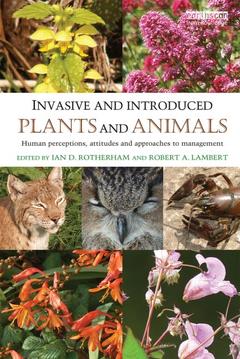Invasive and Introduced Plants and Animals Human Perceptions, Attitudes and Approaches to Management
Coordonnateurs : Rotherham Ian D., Lambert Robert A.

There have been many well-publicized cases of invasive species of plants and animals, often introduced unintentionally but sometimes on purpose, causing widespread ecological havoc. Examples of such alien invasions include pernicious weeds such as Japanese knotweed, an introduced garden ornamental which can grow through concrete, the water hyacinth which has choked tropical waterways, and many introduced animals which have out-competed and displaced local fauna.
This book addresses the broader context of invasive and exotic species, in terms of the perceived threats and environmental concerns which surround alien species and ecological invasions. As a result of unprecedented scales of environmental change, combined with rapid globalisation, the mixing of cultures and diversity, and fears over biosecurity and bioterrorism, the known impacts of particular invasions have been catastrophic. However, as several chapters show, reactions to some exotic species, and the justifications for interventions in certain situations, including biological control by introduced natural enemies, rest uncomfortably with social reactions to ethnic cleansing and persecution perpetrated across the globe. The role of democracy in deciding and determining environmental policy is another emerging issue. In an increasingly multicultural society this raises huge questions of ethics and choice. At the same time, in order to redress major ecological losses, the science of reintroduction of native species has also come to the fore, and is widely accepted by many in nature conservation. However, with questions of where and when, and with what species or even species analogues, reintroductions are acceptable, the topic is hotly debated. Again, it is shown that many decisions are based on values and perceptions rather than objective science. Including a wide range of case studies from around the world, his book raises critical issues to stimulate a much wider debate.
Part 1: Setting the Scene. 1. Balancing Species History, Human Culture and Scientific Insight: Introduction and Overview. 2. Human Interactions with Non-Native Species Part 2: Attitudes and Perceptions. 3. Over Here: American Animals in Britain. 4. How the Concept of Alien Species Emerged and Developed in Twentieth-Century Britain. 5. Nativeness and Nationhood: What Species 'Belong' in Post-devolution Scotland? 6. Who is the Invader? Alien Species, Property Rights, and the Police Power. 7. Whales, Whitefellas and the Ambiguity of 'Nativeness': Reflections on the Emplacement of Australian Identities. 8. The Rise of Modern Invasion Biology and American Attitudes Towards Introduced Species. 9. Anekeitaxonomy: Botany, Place and Belonging. 10. The other Side of Bio-Invasion: The Example of Acclimatization in Germany Part 3: Case Studies and Case Histories. 11. Strangers in a Familiar Land: The Return of the Native 'Aliens' and the (Re)wilding of Britain's Skies, 1850-2010. 12. Public Perception of Invasive Alien Species in Mediterranean Europe. 13. The Human Dimensions of Invasive Plants in Tropical Africa. 14. Plant Invasions – The Case of Acclimatisation and wild Gardeners. 16. Factors Affecting People's Response to Invasive Species Management. 17. The Paradox of Invasive Species in Ecological Restoration: Do Restorationists Worry about Them Too Much or Too Little? 18. A View from Continental Europe: The Case-study of Prunus Serotina in France in Comparison with other Invasives. 19. Native or Alien? The Case of the Wild Boar in Britain. 20. Exotic and Invasive Species: An Economic Perspective. 21. Satisfaction in a Horse: The Perception and Assimilation of an Exotic Animal into Maori Custom Law. 22. Fire and Loathing in the Fynbos: Notions of Indigenous and alien vegetation in South Africa's Western Cape, c.1902-1945 23. Biological Invasion and Narratives of Environmental History in New Zealand, 1800-2000s. Part 4: The Way Ahead: Conclusions and Challenges. 24. Good Science, Good History and Pragmatism: Managing the way ahead. Index
Ian Rotherham is a leading researcher and writer on ecological history with a long-standing interest in exotic and invasive animals and plants. He is a Reader, Director of the Geography, Tourism, and Environment Research Unit, and International Research Co-ordinator at Sheffield Hallam University, UK.
Rob Lambert has a dual appointment at the University of Nottingham, UK, as lecturer in environmental history and lecturer in tourism and the environment. He is also a Senior Honorary Research Fellow at the University of Western Australia and co-editor of the journal Environment and History.
Date de parution : 05-2013
15.6x23.4 cm
Date de parution : 04-2011
Ouvrage de 320 p.
15.6x23.4 cm
Thèmes d’Invasive and Introduced Plants and Animals :
Mots-clés :
species; alien; biological; invasions; ruddy; duck; japanese; knotweed; native; red; Pitcairn Island; Ring Necked Parakeets; Grape Vine; Parthenium Hysterophorus; Ruddy Ducks; Red Grouse; Japanese Knotweed; Wild Boar; Carpobrotus Edulis; Giant Hogweed; Chromolaena Odorata; Garlic Mustard; Zebra Mussel; Invasive Alien Plants; Ngati Raukawa; Acclimatization Societies; Golden Gate National Recreation Area; Invasive Species; South Africa’s Western Cape; Red Squirrel; Biological Invasions; Casuarius Casuarius; Ngati Haua; CFK; Indian Childhood Cirrhosis



